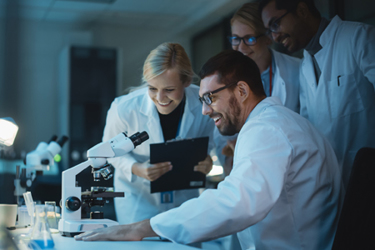6 Tips For Successful Drug Discovery Teamwork
By Diane Hollenbaugh, Ph.D., chief scientific officer, Bonum Therapeutics

In my two previous articles, I’ve discussed the need to think about the big picture in drug research and development, as well as considerations that can improve one’s chances for success at the bench level. Overall, however, science is a team effort. And while people don’t always think about the choreography of good scientific teamwork, there are factors that should be considered and skills that can be developed to increase a drug discovery team’s overall effectiveness and chance of success.
1. Learn The Big Picture Context Of Your Efforts
Like any team sport, there are many different positions to be played in drug R&D. A team does best when everyone knows the objectives of the game and contributes their skills to the group. As in most sports, you can play your position so much better if you understand the game from the point of all the other roles. In drug discovery, for example, this means you can be a more effective biological researcher if you develop an understanding of what your medicinal chemist colleagues might need, and vice versa. It also applies when you represent your function in an early development team, where functional areas as diverse as regulatory affairs, toxicology, manufacturing, and clinical development come together.
Increasingly, understanding how your science will fit into the broader development and commercial strategies down the road can help your team better contribute to the overall goal of producing an effective and impactful drug. This does not mean you need to become an expert in every area, and trying to be is counterproductive. But understanding the big picture gives you a clearer view of the road forward, helps you see things from different perspectives, alerts you to potential potholes, and enables you to communicate more effectively with team members.
2. Learn How To Help Your Teammates
The most successful teams bring together a range of scientific ideas, diverse ways of viewing the same data, different risk sensitivities, structured versus unstructured thinkers, pragmatists and idealists, pessimists and optimists, and everything in between. While we are often laser-focused on our own space, it is good to remember you, too, are one of these collaborators. Appreciating the diversity and strengths of other team members, and bringing flexibility to how you interact with them, helps you and the team achieve greater success. And with any group of individuals, there will be times when there are challenging people to work with – team members who don’t “get it,” who are ego-driven, have particular sensitivities, or who may be hyper-focused on their assigned role.
Acknowledge that not everyone will have the same approach, and bring the same strategic thinking that you apply to a scientific problem to consider how to work effectively with those individuals to get what you and the overall team need.
3. Slower Is Sometimes Faster
One of the fun parts of science is when we come up with an idea for a new thing to do. In our excitement, we can be tempted to run off and design something really big, to answer multiple questions all at once, and get those answers as quickly as possible. Those times can be stimulating and informative, but often more intentional deliberation is needed – especially when there might be a looming time pressure, like a grant deadline or presentation to management, or when the voices of other scientists with disparate views or ways of thinking have not been heard or well understood. Often, it can ultimately be more productive to slow down and consider what distinct objectives are being addressed. This concept applies equally to a single experiment, an overall experimental plan, or to a larger strategic plan or direction.
4. How You Say It Matters
Communicating effectively with others can be complicated by the words we choose, especially in the best diverse teams, where people’s training and experiences can vary greatly. We use many terms that have very specific technical meaning and many that are shorthand for what we mean. Even a simple word like “flask” will conjure up a different image for a chemist than a cell biologist – a glass round-bottom flask with a ground glass stopper and a sterile disposable rectangular flask with a vented cap are all just “flasks”! The result is that the language that one person uses may not be understood in the same way by others, potentially leading to miscommunication and messy thinking.
This idea goes even further, though. We use the same shorthand words in how we think about our work. But by using more precise language when you think about a problem, design an experiment, or try to understand some results, any disconnects become clear and you can more readily and accurately see the problem you are working on.
5. Creativity Comes In Many Forms
There is bold creativity in coming up with a whole new idea or field of exploration. But “everyday creativity” also holds much value. It can come in the form of a new way to make an assay more efficient, a different way to troubleshoot a problematic piece of equipment, the order in which experiments should be done, or how to communicate a complicated thought – all the small things that can add up to the bigger ones. Don’t overlook developing your skills in thinking creatively about everyday matters, and don’t overlook the people who are good at such things.
6. Beware Of The Squirrel
Many dog owners will be well familiar with the pup who can’t resist turning its full attention to any squirrel that appears. Squirrels are everywhere to offer distractions and can take many forms. There will always be a new and amazing technology, a new tool, an exciting discovery. But while it is very important to always be learning new things, they may not apply to the work you are doing right now. Follow them, learn from them, apply them, but don’t chase them. Squirrels are very hard to catch and if you chase one, you waste time and you lose sight of all the other important discoveries you can make.
Creating and bringing forward potential new therapies is a challenging and rewarding field of endeavor. Throughout this series of articles, I’ve touched on three themes that tie together and impact each other in different ways: the central importance of biology and quality data to successful drug discovery; considerations from the lab bench that can improve productivity and chances for success; and how one can help a team to pull together more effectively toward the ultimate common goal – getting to a good drug. We have a wonderful responsibility to do R&D right and ultimately help make a difference in people’s lives.
About The Author:
 Diane Hollenbaugh, Ph.D., is a drug discovery scientist and chief scientific officer of Bonum Therapeutics. She has more than 25 years of experience in biologicals research, research management, and discovery and early development with a focus on immunology and oncology. Previously, she was executive director, immuno-oncology discovery at AbbVie, where she oversaw the growth of IO efforts, including early discovery and translational science, licensing partnerships, and five discovery projects brought to IND. Prior to AbbVie, she has experience at large and small companies, including BMS, Medarex, FivePrime Therapeutics, and Schering-Plough/Merck. She received a B.S. in chemistry from the University of Washington, a Ph.D. from the California Institute of Technology Division of Chemistry and Chemical Engineering, and completed her postdoc training at the Bristol-Myers Squibb Pharmaceutical Research Institute. She is an inventor on more than 20 issued patents.
Diane Hollenbaugh, Ph.D., is a drug discovery scientist and chief scientific officer of Bonum Therapeutics. She has more than 25 years of experience in biologicals research, research management, and discovery and early development with a focus on immunology and oncology. Previously, she was executive director, immuno-oncology discovery at AbbVie, where she oversaw the growth of IO efforts, including early discovery and translational science, licensing partnerships, and five discovery projects brought to IND. Prior to AbbVie, she has experience at large and small companies, including BMS, Medarex, FivePrime Therapeutics, and Schering-Plough/Merck. She received a B.S. in chemistry from the University of Washington, a Ph.D. from the California Institute of Technology Division of Chemistry and Chemical Engineering, and completed her postdoc training at the Bristol-Myers Squibb Pharmaceutical Research Institute. She is an inventor on more than 20 issued patents.
